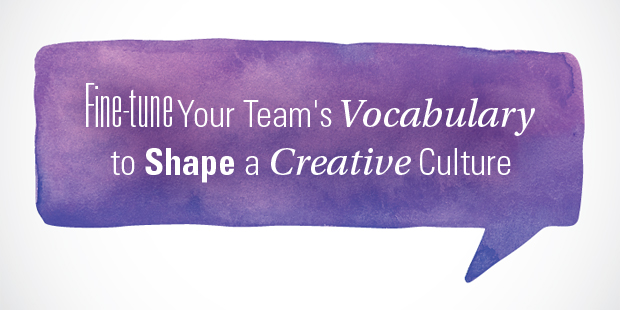
Fine-Tune Your Team’s Vocabulary to Shape a Creative Culture
To change attitudes and behaviors, it helps first to change the vernacular. – David and Tom Kelley, IDEO
Language is the crystallization of thought. But the words we choose do more than just reflect our thought patterns—they shape them. What we say—and how we say it—can deeply affect a company’s culture. To spark innovation, it helps to influence the dialogue around new ideas.
David and Tom Kelley are the founders and partners in IDEO, one of the world’s leading innovation and design firms. According to the Kelley’s, IDEO’s favorite antidote to negative speech patterns is the phrase “How might we…?” It was introduced to them by Charles Warren, now salesforce.com’s senior vice president of product design, as an optimistic way of seeking out new possibilities in the world. In a matter of weeks, it went viral at their firm and it’s stuck ever since. In three disarmingly simple words, it captures much of IDEO’s perspective on creative groups:
- The “how” suggests that improvement is always possible. The only question remaining is how you will find success.
- The word “might” temporarily lowers the bar a little. It allows you to consider wild or improbable ideas instead of self-editing from the very beginning, giving you more chance of a breakthrough.
- And the “we” establishes ownership of the challenge, making it clear that not only will it be a group effort, but it will be our group.
Using this phrase is not just a matter of semantics. Thoughts become words, and words become deeds. If you get the language right, it affects behavior.
Defenders of the status quo often say, “We’ve always done it this way” or “Nobody does it like that.” With a series of “why” questions, an eight-year-old could disarm such defenses.
But adults sometimes forget the simple power of words.
Try fine-tuning your group’s vocabulary, and see the positive effect it has on your culture.
Adapted from Creative Confidence, by David and Tom Kelley.
Would you like help in fine-tuning your team’s vocabulary? Connect with an Auxano Navigator and start a conversation with our team.

Tags: Awareness, Creative Confidence, Culture, Tom and David Kelley, team culture












